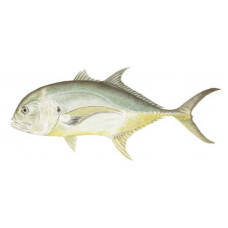Latin name
Caranx hippos; Caranx caninus
Other names
Сommon jack, crevally, toro, trevally, horse crevalle; Spanish: cavallo, chumbo, cocinero, jurel común. Toro, crevally, cavalla, jiguagua; Spanish: aurel, burel, canche jurel, chumbo, cocinero, jurel toro, jurelito, sargentillo.
Identification
Both species are bluish-green or greenish gold on the back and silvery or yellowish on the belly. They are compressed, their deep body has a high rounded profile, and a large mouth. The tail and anal fin may be yellowish, and the dorsal fin ends and upper part of the tail are sometimes black. There is a prominent black spot on the gill cover and another at the base of each pectoral fin. The soft dorsal and anal fins are almost identical in size. Externally, the two species differ from each other only in the presence of a larger maximum number of scales, up to 42 in the Pacific Crevalle Jack, compared to 26-35 in the Crevalle Jack.
Distribution
In the western Atlantic Ocean, crevalle jacks are found from Nova Scotia south to the northern Gulf of Mexico. In the eastern Pacific, they are found from San Diego, California, to Peru.
Habitat
Both species can tolerate a wide range of salinity and often inhabit coastal areas with brackish water, and may also move up rivers, often visiting coastal reefs, harbors, and sheltered bays. Small fish are sometimes found on the sandy and muddy bottoms of very shallow bodies of water, as in estuaries and rivers. They are common in depths up to 130 feet and often move to cooler and deeper waters in the summer. Keeps most frequently in small flocks near shores.
Size
With an average weight of 3 to 5 pounds and a length of 1 to 21⁄2 feet, crevalle jack can reach 10 pounds. Pacific crevalle jack are usually smaller. The world record for crevalle jack is an Angolan fish weighing 58 pounds and for Pacific crevalle jack is a Costa Rican fish weighing 39 pounds.
Life history and Behavior
Spawning takes place in the sea from March to September. Young fish gather in small or large, fast-moving schools. Larger fish are often kept singly.
Food and feeding habits
Voracious predators, feeding on shrimp, other invertebrates and small fish. Often corner a cluster of bait fish near the surface and feed or chase their prey on beaches and offshore jetties. Fish of both species usually grunt or squawk when caught.
Reproduction
No information
| Classification | |
| Phylum | Chordata |
| Class | Actinopterygii |
| Squad | Carangiformes |
| Family | Carangidae |
| Genus | Caranx |
| Species | C. caninus |
| Features | |
| Conservation status | Least Concern |
| Habitat | Pelagic |
| Life span, years | 37 |
| Maximum body weight, kg | 19.7 |
| Maximum length, cm | 101 |
| Sailing speed, m/s | No information |
| Threat to people | Edible |
| Way of eating | Predator |
Jack, Crevalle; Jack, Pacific Crevalle
Tags: Jack, Crevalle; Jack, Pacific Crevalle



